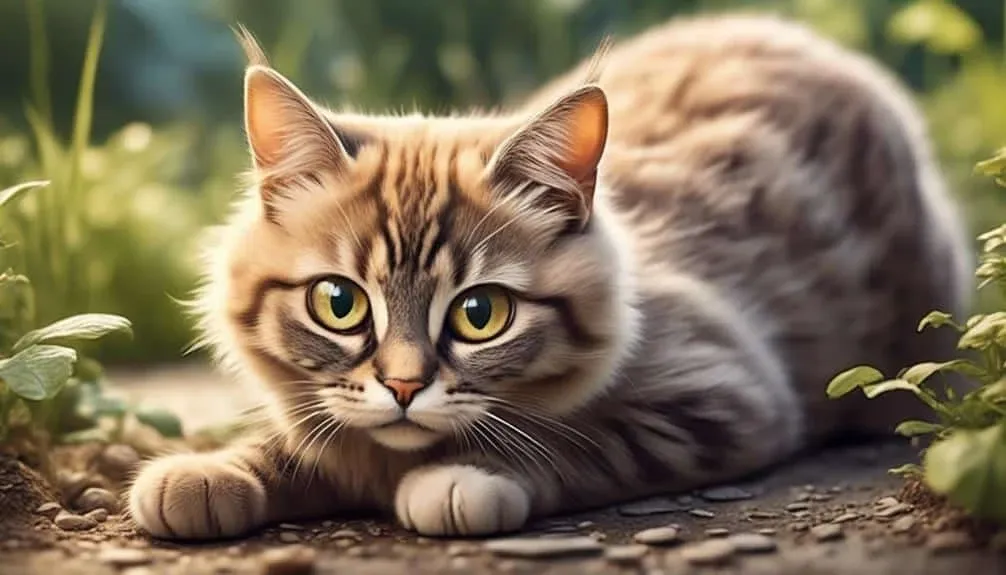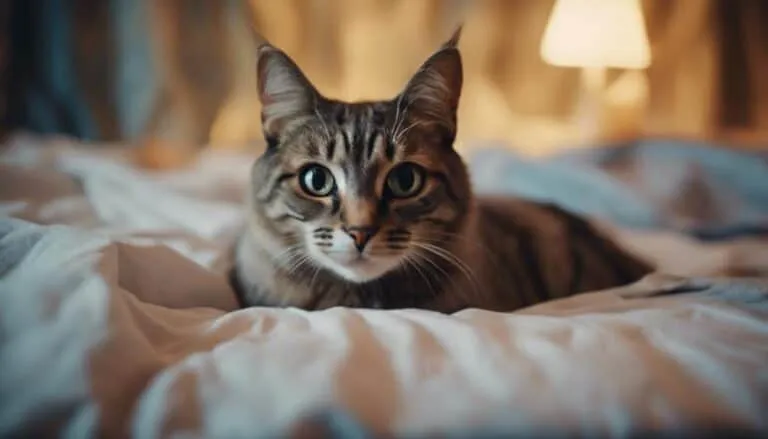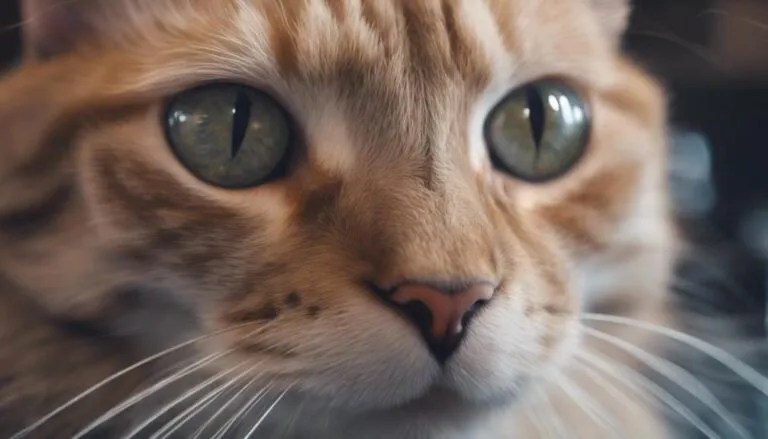The Best Fluffy Pancakes recipe you will fall in love with. Full of tips and tricks to help you make the best pancakes.

The sight of a cat gracefully flopping down in front of its owner has long been a subject of fascination among feline enthusiasts. This intriguing behavior, however, is not merely a random act but holds deeper meaning and purpose.
While some may assume it is a display of submission or an invitation for belly rubs, the reality is far more complex. In this article, we will explore the fascinating reasons behind cats' flopping behavior, examining the various factors that influence and shape this captivating display.
By understanding the true significance of the feline flop, we can deepen our connection with our furry companions and unravel the mysteries that lie within their enigmatic nature. So, join us as we embark on a journey to uncover the secrets behind cats' flopping behavior and discover the hidden depths of our feline friends.
Key Takeaways
- Cats' flopping behavior can have multiple reasons, including seeking attention, marking territory, displaying mating behavior, reacting to catnip, and engaging in playful behavior.
- The feline flop is often misunderstood and misinterpreted, with some mistaking it as a sign of submission. It is important to consider the context and other body language cues to understand the behavior.
- The feline flop indicates trust and affection and is a sign that the cat feels comfortable and safe. Building trust plays a crucial role in feline behavior and strengthening the bond with the cat.
- Interpreting the feline flop in context provides insights into the cat's emotional state and comfort, and it is important to pay attention to the cat's previous experiences, environment, and relationship to respond appropriately to their needs.
Reasons for Cats' Flopping Behavior
The behavior of cats flopping down can be attributed to various reasons, which include seeking attention, marking territory, displaying mating behavior, reacting to catnip, engaging in playful behavior, and seeking sensation and comfort.
Cats' flopping behavior is often misunderstood, as it is commonly misinterpreted as a sign of submission. However, it is important to recognize that cats use a variety of communication signals, and the feline flop is just one of them.
Miscommunication can also occur when humans attempt to give belly rubs, as cats may have different interpretations of this gesture. It is crucial to consider the context in which the feline flop occurs, as it can vary depending on the individual cat and the environment.
Understanding the meaning and significance of the feline flop can help foster a stronger bond and relationship between cats and their owners.
Misinterpretations and Miscommunication
Misinterpretations and miscommunication often arise when attempting to understand the behavior of cats flopping down. This misunderstood behavior can lead to confusion and misinterpretations, particularly when it comes to belly rubs.
While some may assume that a cat flopping down is a sign of submission, this is not necessarily the case. Cats have different interpretations of the feline flop, and their motivations can vary based on factors such as their mood, environment, and relationship with their owner.
It is crucial to interpret the feline flop in context, considering other body language cues and the overall behavior of the cat. Belly rub confusion can occur when owners assume that a flopping cat wants a belly rub, when in reality, they may be seeking attention, marking territory, or simply seeking comfort.
Understanding these nuances can help reduce miscommunication and strengthen the bond between cats and their owners.
Factors Influencing the Feline Flop
Several factors can influence a cat's decision to flop down in front of you. Cats are highly attuned to their environment and communicate through various behavioral cues. Factors influencing body language, such as seeking attention, marking territory, and mating behavior, can play a role in the feline flop.
Additionally, cats may flop down in response to a reaction to catnip or as a form of playful behavior. Sensation and comfort also contribute to their decision to flop.
It is important to interpret the feline flop in context, as different interpretations exist. Understanding these factors influencing the feline flop can help us better communicate with our feline companions and respond appropriately to their needs.
Meaning and Significance of the Feline Flop
Understanding the factors that influence a cat's decision to flop down in front of you can provide valuable insights into the meaning and significance of this feline behavior. Flopping is a form of feline body language that often indicates trust and affection.
When a cat chooses to flop in your presence, it is a sign that they feel comfortable and safe in your presence. Trust plays a crucial role in feline behavior, and when a cat trusts their owner, they may exhibit this behavior as a way of showing their bond.
It is important to interpret the feline flop in context, considering the individual cat's behavior and preferences. Responding positively to the feline flop, with gentle petting or play, can further strengthen the bond between the cat and its owner.
Interpreting the Feline Flop in Context
The interpretation of a cat's flopping behavior can provide valuable insights into their current emotional state and level of comfort. Cats communicate through body language, and understanding their communication is crucial for building a strong bond with them.
When a cat flops down in front of you, it can indicate a sense of trust and relaxation. However, it is essential to interpret this behavior in context. Factors such as the cat's previous experiences, the environment, and the relationship between the cat and its owner can influence the meaning of the feline flop.
It is important to pay attention to other body language cues, such as tail position and ear position, to get a comprehensive understanding of the cat's emotions. By interpreting the feline flop in context, we can better respond to the cat's needs and provide appropriate care and attention.
Responding to the Feline Flop
When a cat flops down in front of you, it is important to respond appropriately in order to maintain and strengthen the bond between you and your feline companion. Building trust and promoting positive interactions are key factors in responding to the feline flop.
Here are four ways you can respond to your cat's flopping behavior:
- Provide gentle strokes and scratches: Cats often flop down to seek attention and physical affection. By gently petting and scratching your cat, you are acknowledging their need for interaction and reinforcing the bond between you.
- Engage in play: Flopping can also be a playful behavior. Respond to your cat's flop by initiating a play session with toys or interactive games. This will not only entertain your cat but also provide them with mental stimulation and exercise.
- Offer treats or rewards: Positive reinforcement is an effective way to strengthen the bond with your cat. When your cat flops down, reward them with a treat or praise. This will associate their flopping behavior with positive outcomes and encourage them to continue engaging in this behavior.
- Respect their space: Sometimes, cats flop down as a way to find comfort and relaxation. In such cases, it is important to respect their need for personal space. Allow them to rest undisturbed and observe from a distance. This will show your cat that you understand and respect their boundaries, further strengthening the trust between you.
Individual Variation in Flopping Behavior
There is significant individual variation in the flopping behavior of cats. Understanding the motivations behind this behavior and identifying behavioral patterns can provide valuable insights into the unique preferences of each cat.
Cats may flop down for a variety of reasons, such as seeking attention, marking territory, exhibiting mating behavior, reacting to catnip, engaging in playful behavior, or simply seeking sensation and comfort.
By observing and interpreting the context in which a cat flops down, owners can gain a better understanding of their cat's behavior and preferences. The bond and relationship between the cat and its owner also play a role in the individual variation of flopping behavior.
Understanding Your Cat's Preferences
Understanding the unique preferences of your cat is essential for developing a strong bond and fostering a harmonious relationship with your feline companion. Cats communicate in various ways, and recognizing the signs of feline trust is crucial in understanding their preferences.
Here are four key aspects to consider when understanding your cat's preferences:
- Body language: Cats use their body language to communicate their preferences. Pay attention to their tail movements, ear positions, and facial expressions to gauge their comfort level and preferences.
- Vocalizations: Cats may use different vocalizations to express their desires. Purring, meowing, or chirping can indicate their preferences for attention, food, or play.
- Preferred activities: Each cat has its own unique preferences when it comes to activities. Some cats may prefer interactive play, while others may enjoy quiet cuddle sessions. Observe your cat's behavior and provide opportunities for their preferred activities.
- Personal space: Cats value their personal space and may have individual preferences for physical contact. Some cats enjoy being petted and cuddled, while others may prefer to have their own space. Respect their boundaries and provide them with the space they need.
The Bond and Relationship With Your Cat
Developing a strong bond and fostering a harmonious relationship with your cat is essential for their well-being and overall quality of life. Building a strong bond requires understanding cat behavior and responding to their needs appropriately.
Cats are highly independent animals, but they also crave companionship and social interaction. Spending quality time with your cat, engaging in interactive play, and providing them with a stimulating environment can help strengthen the bond between you and your feline companion.
Understanding their body language and respecting their boundaries is crucial for establishing trust. Additionally, providing consistent and positive reinforcement can further enhance the bond.
Reinforcement and Training
Fostering a strong bond with your cat requires implementing effective reinforcement and training techniques. Positive reinforcement is an essential tool in training your cat. By rewarding desired behaviors, such as sitting or using a scratching post, you can encourage your cat to repeat these actions. Training techniques that utilize positive reinforcement, such as clicker training or treat rewards, can be highly effective in shaping your cat's behavior.
To effectively reinforce and train your cat, consider the following techniques:
- Consistency: Set clear expectations and consistently reinforce desired behaviors. Use the same cues and rewards each time to avoid confusion.
- Patience: Cats may take time to learn and respond to training. Be patient and avoid punishments or negative reinforcement, as these can damage the bond between you and your cat.
- Environmental enrichment: Provide your cat with a stimulating environment that includes toys, scratching posts, and interactive play. This can help redirect unwanted behaviors and keep your cat mentally and physically active.
- Professional guidance: If you're struggling with training or behavior issues, consult with a professional cat behaviorist or trainer. They can provide personalized guidance and help address specific challenges.
Frequently Asked Questions
Can a Cat's Flopping Behavior Be a Sign of Aggression or Fear?
A cat's flopping behavior is typically not a sign of aggression or fear. It is more commonly a display of trust and affection. Other possible reasons behind a cat's flopping behavior include seeking attention, marking territory, and seeking comfort. Flopping behavior differs from other feline behaviors like rolling or stretching in that it is often accompanied by a relaxed body posture and a desire for interaction with their owner.
How Can I Tell if My Cat Is Flopping Down to Mark Their Territory or Seeking Attention?
A cat's flopping behavior differs from other forms of marking territory by being more of a social and attention-seeking behavior. The potential health benefits of flopping include stress relief, muscle relaxation, and bonding with their owner.
Are There Any Specific Body Language Cues That Indicate a Cat Is About to Flop Down?
There are no specific body language cues that indicate a cat is about to flop down. Cats' flopping behavior is a complex and multifaceted expression influenced by a variety of factors, including social hierarchy and physiological benefits.
Can a Cat's Flopping Behavior Be Influenced by Their Age or Breed?
A cat's flopping behavior can be influenced by their age and breed. Younger cats may flop more frequently as they are more playful, while certain breeds may be more prone to flopping due to their personality traits.
Is It Possible to Train a Cat to Flop Down on Command?
Training a cat to flop down on command is possible, although it may require patience and consistency. By using positive reinforcement and rewards, cats can learn to associate the command with the behavior, providing mental stimulation and strengthening the bond between cat and owner.
Conclusion
In conclusion, the flopping behavior of cats is a fascinating and complex topic that can be influenced by a variety of factors. Misinterpretations and miscommunication often arise when trying to understand the true meaning behind this behavior.
By considering individual variation, context, and the bond between the cat and its owner, we can begin to unravel the intriguing reasons behind cats' flopping behavior.
Remember, just like humans, cats have their own unique preferences and motivations, and nurturing a strong bond through positive interactions is key to understanding them better.
As the saying goes, 'A picture is worth a thousand words,' and by observing and interpreting their behavior, we can gain valuable insights into our feline companions.








